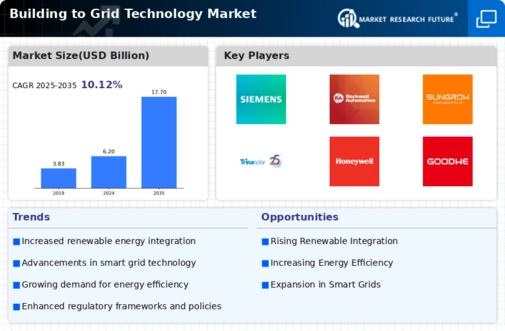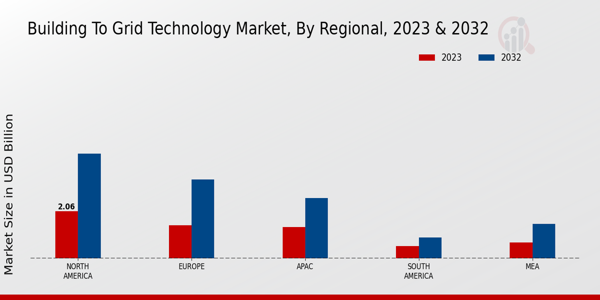Market Growth Projections
The Global Building to Grid Technology Market Industry is poised for substantial growth, with projections indicating a market size of 6.2 USD Billion in 2024 and an anticipated increase to 17.7 USD Billion by 2035. This growth trajectory reflects a compound annual growth rate of 10.03% from 2025 to 2035. Such figures highlight the increasing importance of building to grid technologies in the global energy landscape. The market's expansion is likely to be driven by factors such as rising energy demands, advancements in technology, and supportive government policies. These projections underscore the potential for innovation and investment in this sector.
Government Incentives and Policies
Government incentives and policies play a pivotal role in shaping the Global Building to Grid Technology Market Industry. Various nations implement supportive frameworks to encourage the adoption of smart grid technologies. These initiatives may include tax credits, grants, and subsidies aimed at both consumers and businesses. For instance, the U.S. Department of Energy has launched programs to promote energy efficiency and grid modernization. Such policies not only stimulate market growth but also foster innovation in building to grid technologies. As governments worldwide prioritize sustainability, the alignment of policies with market needs is likely to enhance the overall adoption of these technologies.
Urbanization and Smart City Initiatives
Urbanization and smart city initiatives are driving forces behind the Global Building to Grid Technology Market Industry. As urban populations grow, the demand for efficient energy management systems becomes more pronounced. Smart city projects often incorporate building to grid technologies to optimize energy use and enhance sustainability. For example, cities like Singapore and Barcelona are implementing smart grid solutions to manage energy resources effectively. This trend not only addresses the challenges of urbanization but also aligns with global sustainability goals. The integration of building to grid technologies within smart city frameworks is likely to propel market growth in the coming years.
Consumer Awareness and Energy Management
Consumer awareness regarding energy management is increasingly shaping the Global Building to Grid Technology Market Industry. As individuals become more conscious of their energy consumption and its environmental impact, the demand for smart building solutions rises. Technologies that enable real-time monitoring and control of energy use empower consumers to make informed decisions. This shift towards energy efficiency is supported by educational campaigns and initiatives from various organizations. As consumers seek to reduce their energy bills and carbon footprints, the adoption of building to grid technologies is expected to gain momentum, further driving market growth.
Technological Advancements in Smart Grids
Technological advancements significantly influence the Global Building to Grid Technology Market Industry. Innovations in smart grid technologies, such as advanced metering infrastructure and real-time data analytics, enhance the efficiency and reliability of energy distribution. These advancements facilitate better communication between buildings and the grid, enabling demand response and energy management strategies. As a result, energy consumption patterns can be optimized, leading to cost savings for consumers and utilities alike. The ongoing evolution of these technologies suggests a promising future for the market, as stakeholders increasingly recognize the benefits of integrating building systems with grid operations.
Rising Demand for Renewable Energy Integration
The Global Building to Grid Technology Market Industry experiences a notable surge in demand for renewable energy integration. As countries strive to meet their climate goals, the transition towards renewable sources such as solar and wind energy becomes imperative. This shift not only reduces carbon emissions but also enhances energy security. In 2024, the market is projected to reach 6.2 USD Billion, reflecting the growing investments in smart grid technologies. By 2035, the market is expected to expand to 17.7 USD Billion, indicating a robust compound annual growth rate of 10.03% from 2025 to 2035. Such trends underscore the critical role of building to grid technology in facilitating this transition.














